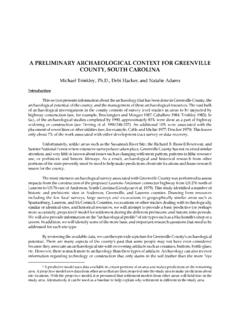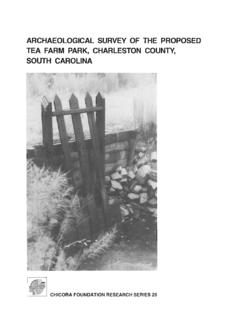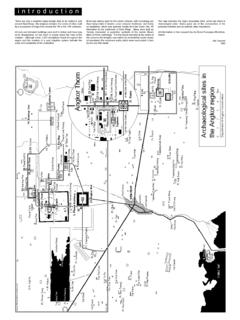Transcription of Guidelines for the Storage and Display of Archaeological ...
1 1 2013 Guidelines for the Storage and Display of Archaeological Metalwork 776 Contents How to get the most out of this Section 1: What is Archaeological metalwork?..3 What is corrosion?..3 Consequences of corrosion for objects6 Preventing and managing active Stopping or controlling corrosion? 7 Taking a proactive 7 Section 2: Guidelines for Storage and Display of 7 Iron .. 7 Identifying 7 Signs of active 8 Causes of active corrosion .. 9 Storage and Display Copper Identifying copper Signs of active Causes of active corrosion ..11 Storage and Display Lead and its alloys ..12 Identifying lead and its alloys ..12 Signs of active Causes of active corrosion ..12 Storage and Display Silver, gold and their alloys ..13 Identifying Signs of silver corrosion.
2 13 Causes of active corrosion ..14 Storage and Display Other Aluminium ..15 Zinc ..15 Tin ..15 Nickel and Stainless steels ..16 Section 3:Achieving standards for Storage and Planning a Display ..16 Achieving good RH control in Storage ..18 Pollutants in Methods for controlling Desiccation and Passive control Active control methods ..18 Methods for controlling External Internal Using sorbents and barriers ..20 Reducing pollutant concentration20 Environmental Monitoring relative humidity ..21 Monitoring MEMORI reader and Glossary ..24 How to get the most out of this guide Metal artefacts are found on the majority of Archaeological sites of late prehistory onwards. They comprise objects from every arena of human life, from everyday tools to coinage to valuable high-status provide vital information about the development of human technology and are an important resource for archaeologists investigating the past.
3 Metals are among the most vulnerable types of materials, as they will often undergo deterioration after excavation. Appropriate Storage and Display conditions are key to preserving Archaeological metals. These Guidelines are intended for anyone involved in the Storage and Display of Archaeological metals, including conservators, curators, archaeologists and museum assistants. It includes an introduction to the reasons why metal objects require particular Storage conditions, with detail on the specific problems faced by each metal, based on the latest research. When planning new Storage or displays this guide will help to design and implement appropriate environmental controls. It is advisable to consult a conservator in the early stages of planning to address the specific needs of particular get the most from these Guidelines they should be used in conjunction with the case studies and additional information on the webpages.
4 The guide will facilitate conversations between conservators and decision makers as well as providing recommendations and examples of best practice. It will help to set priorities and be proactive in avoiding the worst environments and preventing problems occurring, as well as identifying material at risk and discussing how to reduce case studies illustrate how the latest conservation science is developing pragmatic, evidence-based conservation strategies. Although some limits are recommended, these Guidelines are not solely prescriptive; instead, the emphasis is on the need to balance risk to objects against other relevant factors, such as the type of object, the Display context, and the resources and costs will equip the reader to address cost benefit outcomes of their decisions. It also provides a base line of knowledge to evaluate new or conflicting research and recommendations. The focus of the Guidelines is on strategies for preventive conservation rather than interventive treatments.
5 It does not include procedures for storing objects immediately after excavation; this is covered in First Aid for Finds(Watkinson and Neal 2001).This guide is for objects that have been accessioned to an Archaeological archive or store where they will remain for the medium to long term requiring management to survive. It also contains information on designing and maintaining good showcase and Storage environments, and therefore will be useful to anyone involved in maintaining or displaying Archaeological metal collections. The most common metals found on terrestrial Archaeological sites are covered here: iron, copper, lead, silver, gold and their is some mention of modern metals, which are rarely found in the Archaeological record at present but which will become a larger part of Archaeological collections in the future. It does not cover artefacts from marine contexts or historic material, although some of the research on which this guide is based is relevant to both contexts.
6 Issues such as handling, packaging, radiography, interventive conservation or buildings management are not covered, and information on these may be found in other publications, which the reader is urged to use in tandem with this guide. Section 1 outlines some basic definitions and introduces information relevant to all metals. It gives information on the most important considerations to be borne in mind when storing and displaying metal artefacts. Section 2 provides information and recommendations on preventing and controlling deterioration of metals found on Archaeological sites. References are given to the research on which the recommendations are based. Section 3 describes methods of implementing Storage and Display conditions. It includes guidance on showcase design and Storage planning, methods of implementing environmental control, and the importance of monitoring and maintenance. 2 Case studies are provided on the webpages to illustrate the principles of the guide in action.
7 A list of suppliers and sources of further information is also provided on the English Heritage web pages (HYPERLINK TO WEB PAGE) . A glossary is provided for the most important technical terms, which are emboldened in the text. The sources of the information in this guide are referenced in standard Harvard format, and key references have been highlighted in each section for the reader who wishes to follow up a topic in more depth. New research on these topics is being produced all the time, and relevant references will be updated on the webpages. Section 1: Introduction What is Archaeological metalwork? Archaeological metalwork is the category of objects made of or containing a metallic element. There are many metals, but only a small number were regularly used in the past to make objects. Although some metals such as gold are found in their elemental state in nature, most metals have to be produced from ores, commonly metal oxide or sulfide minerals.
8 By heating in a low oxygen environment, the metal is extracted from the ore. It can then be further refined, modified and shaped, or melted and poured into moulds to produce objects. An alloy is a mixture of two or more metals, used to manipulate the properties of the material and reduce the cost lowering precious metals content, such as gold, while maintaining their appearance. Non-metallic elements such as carbon were deliberately introduced to change the properties of the material. Small non-metallic particles of slag remain as impurities within the metal from the production process, and also have an effect on the working properties. Following production the metal was shaped or cast into an object. Working the metal changes its properties and its traces can be identified to provide technological information. Inlays and coatings of other metals could be added to enhance the appearance or protect the object (eg tinning or gilding).
9 An artefact could be made of different metal pieces joined together (eg an iron pin on a bronze brooch). Finally, other non-metallic materials could be added to make a complete artefact (eg wooden handles on iron tools) and to decorate it. What emerges from this overview is the complexity of Archaeological metalwork, in that it comprises a small number of metals but in an infinite number of combinations, with many possible impurities, and a large number of resulting variations in properties and behaviour. Fig 1. A medieval tinned iron buckle from a London site. Museum of London Fig 2. Migrograph of slag inclusions in iron spearhead from Sutton Hoo. The Trustees of the British Museum What is corrosion? Metals are inherently unstable during burial and in the atmosphere, and will tend to return to their mineral form over compounds formed by the reaction of the metal with its environment are distinctive in form and colour, and invariably unlike the metal, resulting in a change in the object composition, structure, properties and appearance.
10 In most cases, the corrosion process requires the presence of oxygen and water. Corrosive substances that come into contact with the object can increase the corrosion reaction can be salts from the burial environment, pollutants in the air or even contaminants from past conservation treatments. Fig 3. Metalworking process 3 Fig 4. Micrograph of cross section of patinated lead. The Trustees of the British Museum Fig 5. Iron objects with corrosion after excavation; both have had partial cleaning to reveal their shape Museum of London Corrosion can occur during the use-life of the artefact, during burial and after excavation. The effect of corrosion will vary from a minor surface change to complete loss of the metal. Some corrosion layers protect the object from further corrosion, and provide evidence of use and authenticity. Some corrosion layers enhance the object s appearance and are considered aesthetically desirable; these are termed patinas.







